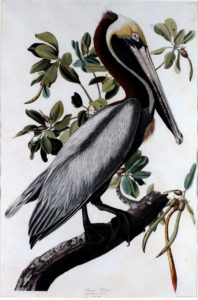Brown Pelican
Declared locally extinct in 1963, the brown pelican population rebounded in the state due to efforts by the Louisiana Department of Wildlife and Fisheries.

New Orleans Museum of Art
Brown Pelican as depicted in John James Audubon's "Birds of America Series", ca. 1828–1838.
The official state bird of Louisiana, the brown pelican (Pelecanus occidentalis) is a year-round coastal resident of the Gulf of Mexico, as well as the Atlantic and Pacific coasts. The brown pelican decorates the state flag and has long been used by countless local businesses, artists, and institutions to symbolize their homegrown connections.
In Louisiana brown pelicans breed and reside on barrier islands, where they nest in mangrove trees. Juvenile pelicans are grayish brown in color. The breeding plumage of adults is a white neck with a rust-orange crown and silvery-grey wings and breast.
One of eight members of the pelican genus (Pelecanus), the brown pelican is famous for its spectacular nosedives, plunging from thirty to seventy feet in the air to prey on fish like menhaden, which it catches in its prodigious gular pouch. They are opportunistic migrators, following their food, though rarely more than twenty miles from the coast.
At midcentury Louisiana’s brown pelican population was decimated by the accumulation of pesticide residues in the Gulf. Manmade insecticides such as DDT and endrin not only poisoned many species of fish-feeding birds but also softened the eggshells of brown pelicans, rendering new broods unviable. The Chandeleur Islands, part of the Breton National Wildlife Refuge established by President Theodore Roosevelt in 1904, housed an estimated 50,000 pelicans in 1918. By 1962 that number had dropped to just six individuals.
The following year, 1963, wildlife authorities declared the species extirpated, or locally extinct. Ironically, the Louisiana state legislature named the brown pelican the state bird in 1966, after failing to do so officially for over a century despite the bird’s appearance on the state flag. The US Endangered Species Conservation Act of 1969 identified the brown pelican as “threatened with extinction.”
In 1968 the Louisiana Wildlife and Fisheries Commission—known today as the Louisiana Department of Wildlife and Fisheries—together with the National Audubon Society hatched a plan to revive the brown pelican in Louisiana. A team of biologists spent the next several years moving groups of young pelicans, just ready to fledge and leave the nest, from healthy Florida colonies to several island habitats in coastal Louisiana.
After numerous failures, the project began to see successes in 1973. (It helped that DDT was banned the preceding year.) Brown pelican colonies soon proliferated on Queen Bess Island (Jefferson Parish), Raccoon Island (Terrebonne Parish), and among the Chandeleur island chain (St. Bernard Parish). The federal government removed the species from the endangered list in 2009. Today Louisiana is home to an estimated 100,000-plus brown pelicans.
But threats to the state’s brown pelican population remain. The Deepwater Horizon oil spill exterminated upwards of 10 percent of the northern Gulf’s brown pelican population. Fishing tackle and other maritime detritus—ropes, hooks, and especially monofilament line—maim and kill untold numbers of the bird annually.
But there is no doubt that the global climate crisis ranks as the pelican’s greatest threat. A 2022 federal report projects that Gulf Coast sea levels will rise fourteen to eighteen inches by 2050, rendering the brown pelican’s island habitats potentially uninhabitable.
